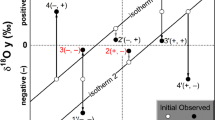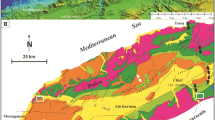Abstract
The report presents original data on the isotope and chemical composition of the nitric thermal, cold underground, and surface natural waters, along with the water-enclosing rocks, of the Ulsk occurrence of thermal mineral waters (coasts of the Sea of Okhotsk, Khabarovsk krai). The data on the concentrations of oxygen and nitrogen isotopes and rare-earth elements, as well as on the volume activity of radon, in the treated underground and surface waters are obtained for the first time. Based on the data of automated monitoring of the physical parameters, the hydrogeological characteristics of the thermal waters are determined and the balneal properties are evaluated. The results obtained show the atmospheric origin of the nitric thermal waters of the Ulsk spring; however, the indicative chemical elements occurring in the considered waters represent the effects of deep-seated high-temperature processes as well. It is found that the waters warmed to 31°C within fractured Paleocene granites do not show significant variations of temperature, and the chemical composition varies exclusively under the interaction with the water-enclosing rocks. The profiles of the distribution of rare-earth elements (REEs) in the thermal waters represent the REE distribution in the water-enclosing granitoids and point to the limitation of the thermal water circulation with the area of the occurrence of the Paleocene granites of the Bekchi–Ul Massif. The temperature of the deep-seated reservoir measured by geothermometers was 80°C or below, which may indicate a depth of water circulation of 1–2 km or less.








Similar content being viewed by others
REFERENCES
A. P. Avtsyn, A. A. Zhavoronkov, M. A. Rish, and L. S. Strochkova, Human Microelementosis, (Meditsina, Moscow, 1991).
V. Antonyuk, T. A. Kantur, and E. V. Kucherova, “Possibility of the application of mineral water in the complex therapy of maxillary acute sinusitis,” Fizioterap., Bal’neol. Reabil., No. 1, 38–43 (2015).
I. V. Bragin and G. A. Chelnokov, “Geochemistry of thermal waters of Sikhote-Alin. Gaseous aspect,” Vestn. DVO RAN, No. 4, 147–151 (2009).
A. Yu. Demonova, N. A. Kharitonova, A. V. Korzun, A. I. Sardorov, and G. A. Chelnokov, “Chemical composition of nitrogen thermal waters of the Khodzha–Obi–Garm balneal climatic desert, Tadjikistan,” Vestn. Mosk. Gos. Univ., Geol. Ser., No. 5, 77–84 (2017).
L. V. Zamana, “Petrogenetic geochemical model of the nitrogen thermal waters of the Baikal Rift zone,” Fundamental Problems of Water and Water Resources at the Turn of the Third Millenium: Proceedings of the International Conference (NTL, Tomsk, 2000), pp. 199–204 [in Russian].
V. A. Kaidalov, B. A. Novoselov, and L. B. Maksimova, State Geological Map of the Russian Federation. 1 : 200 000. 2nd Edition. Nikolaevskaya Series, Sheet N-54-XXI: Explanatory Note (MF VSEGEI, Moscow, 2013) [in Russian].
Classification of Mineral Waters and Therapeutic Muds. Methodical Directions. No. 2000/34 (Moscow, 2000) [in Russian].
V. V. Kulakov and S. V. Sidorenko, Mineral Waters and Therapeutic Mud of the Amur Region (DVGMU, Khabarovsk, 2017) [in Russian].
I. S. Lomonosov, Geochemistry and Formation of Modern Hydrothermal Waters of the Baikal Rift Zone (Nauka, Novosibirsk, 1974) [in Russian].
E. V. Posokhov, General Hydrogeochemistry (Nedra, Leningrad, 1975) [in Russian].
N. A. Kharitonova, E. A. Vakh, G. A. Chelnokov, O. V. Chudaev, I. A. Aleksandrov, and I. V. Bragin, “REE geochemistry in groundwater of the Sikhote Alin fold region (Russian Far East),” Russ. J. Pac. Geol. 10 (2), 141–153 (2016).
E. I. Chernyshev, Report on Detailed Prospecting of Thermal Waters on the Sea Coast of the Nikolaevsk Region: Works of 1986–87. Ul’skii Team (Khabarovsk, 1988) [in Russian].
O. V. Chudaev, Composition and Conditions of the Formation of the Modern Hydrothermal Systems of the Russian Far East (Dal’nauka, Vladivostok, 2003) [in Russian].
O. V. Chudaev, N. A. Kharitonova, G. A. Chelnokov, I. V. Bragin, and E. G. Kalitina, Geochemical Features of the Behavior of Rare-Earth Elements in Waters of the Russian Far East under Conditions of Natural and Anthropogenic Anomalies (Dal’nauka, Vladivostok, 2017) [in Russian].
L. I. Sharueva, B. G. Lopatin, G. V. Roganov, R. A. Sautchenkova, et al., State Geological Map of the Russian Federation. 1 : 1 000 000 (3rd Generation). Far East Series. Sheet N-54. Nikolaevsk-on-Amur: Explanatory Note (Kartograficheskaya fabrika VSEGEI, St. Petersburg, 2016) [in Russian].
A. V. Shulyarenko, “Fluorine in natural waters,” Gidrobiol. Zh., No. 1, 76–91 (2003).
S. Arnorsson, E. Gunnlaugsson, and H. Svavarsson, “The chemistry of geothermal waters in Iceland III. Chemical geothermometry in geothermal investigations,” Geochim. Cosmochim. Acta 47, 567–577 (1983).
I. V. Bragin, G. A. Chelnokov, O. V. Chudaev, N. A. Kharitonova, and S. V. Vysotskiy, “Geochemistry of thermal waters of continental margin of Far East of Russia,” Acta Geol. Sinica 90 (1), 276–284 (2016).
I. V. Bragin, N. A. Kharitonova, G. A. Chelnokov, A. V. Aseeva, and O. V. Chudaev, “REY geochemistry in groundwater from Paratunka Geothermal Area (Kamchatka Peninsula, Far East of Russia),” Environ. Earth Sci. 77, 375–389 (2018).
G. Chelnokov, N. Kharitonova, I. Bragin, and M. Vasil’eva, “Deuterium, oxygen-18 and tritium in precipitation, surface and groundwater in the Far East of Russia,” Proc. Earth & Planet. Sci. 7, 151–154 (2013). https://doi.org/10.1016/j.proeps.2013.03.209
H. Craig, “Isotopic variations in meteoric waters,” Science 133, 1702–1703 (1961).
R. O. Fournier, “Chemical geothermometers and mixing model for geothermal systems,” Geothermics 5, 41–50 (1977).
B. R. Frost, C. G. Barnes, W. J. Collins, R. J. Arculus, D. J. Ellis, and C. D. Frost, “A geochemical classification for granitic rocks,” J. Petrol. 42, 2033–2048 (2001).
P. Möller, P. Rosenthal, S. Geyer, and P. Dulski, “Characterization of recharge areas by rare earth elements and stable isotopes of H2O,” The Water of the Jordan Valley Scarcity and Deterioration of Groundwater and Its Impact on the Regional Development, Ed. by Heinz Hötzl, Peter Möller and Eliahu Rosenthal (Springer–Heidelberg, Berlin, 2008), pp. 123–148.
J. T. O’Connor, “A classification for quartz-rich igneous rocks based on feldspar ratios,” US Geol. Surv. Prof. Pap. B525, 79–84 (1965).
A. Peccerillo and S. R. Taylor, “Geochemistry of Eocene calc-alkaline volcanic rocks from the Kastamonu Area, Northern Turkey,” Contrib. Mineral. Petrol. 58, 63–81 (1976).
S. Shibata, T. Tanaka, and K. Yamamoto, “Crystal structure control of the dissolution of rare earth elements in water–mineral interactions,” Geochem. J. 40, 437–446 (2006).
S. R. Taylor and S. M. McLennan, The Continental Crust: Its Composition and Evolution; an Examination of the Geochemical Record Preserved in Sedimentary Rocks (Blackwell, Oxford, 1985).
N. A. Tchepkaia, G. A. Chelnokov, A. A. Karabtsov, and I. A. Tarasenko, “Hydrochemical characteristics of Lastochka Spa, Primorye, Far East of Russia,” J. Geochem. Explor. 88, 148–152 (2006). https:// doi.org/10.1016/j.gexplo.2005.08.028
User’s Guide AQUACHEM–A Computer Program for Speciation, Reaction-Path, Advective Transport, and Inverse Geochemical Calculation (Waterloo, 2005).
Y. Yourtcever and J. R. Gat, “Atmospheric waters,”Stable Isotope Hydrology (IAEA, Vienna, 1981), pp. 103–142.
ACKNOWLEDGEMENTS
The study was supported by the Russian Scientific Foundation, project no. 18-77-10007.
Author information
Authors and Affiliations
Corresponding author
Additional information
Recommended for publishing by O.V. Chudaev
Translated by A. Rylova
Rights and permissions
About this article
Cite this article
Chelnokov, G.A., Bragin, I.V., Kharitonova, N.A. et al. Geochemistry and Conditions of the Formation of the Ulsk Thermal Spring (Coasts of the Sea of Okhotsk, Khabarovsk Krai). Russ. J. of Pac. Geol. 13, 163–175 (2019). https://doi.org/10.1134/S1819714019020040
Received:
Revised:
Accepted:
Published:
Issue Date:
DOI: https://doi.org/10.1134/S1819714019020040




